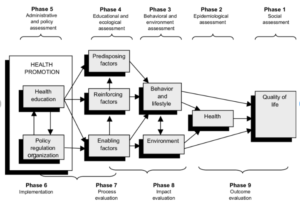Requirements
Preparing Your Applying the PRECEDE Portion of the PRECEDE-PROCEED Model Assignment
For the purpose of this paper:
Choose a health problem or concern that you will explore within a specified population and briefly describe both in one paragraph (e.g., diabetes among adult males aged X to X).
Provide a brief description of Phase 1 of the PRECEDE-PROCEED model: Social Assessment, Participatory Planning, and Situation Analysis, in 1-2 sentences. Identify social indicators to describe quality of life within the specified population and identify potential sources. Identify activities to engage community members in the planning process and provide a brief rationale.
Provide a brief description of Phase 2: Epidemiological, Behavioral, and Environmental Assessments, in 1-2 sentences. Describe the extent of the health problem at the national, state, and local levels and identify your sources of data. Describe behavioral and/or environmental factors linked to the health problem and identify your sources.
Provide a brief description of Phase 3: Educational and Ecological Assessment, in 1-2 sentences. Describe the predisposing, enabling, and reinforcing factors that contribute to the health problem and identify your sources. Identify relevant theories that may apply.
Provide a brief description of Phase 4: Administrative and Policy Assessment, in 1-2 sentences. Describe resources and barriers to program development and implementation and identify potential sources.
Solution
Applying the PRECEDE Portion of the PRECEDE-PROCEED Model
According to Skyler et al. (2017), diabetes is among the leading causes of mortality among individuals aged 65 and above. Diabetes also contributes to heightened risk of institutionalization, and an equally increased risk of chronic cardiovascular and microvascular complications. Data by the CDC (2020) indicates that by 2040, the prevalence of diabetes will double owing to an increasingly aging population. Further, the prevalence of type 2 diabetes which affects the overweight population will increase up to five-fold by 2050 if no measures are taken to avert the situation (CDC, 2020). This essay aims to examine application of the PRECEDE-PROCEED Model in relation to health program planning for diabetic patients of age 65 years and above.

Figure 1: The PRECEDE-PROCEED Model
Source: (Sharma,2021)
Social Assessment, Participatory Planning, and Situation Analysis
The social assessment dimension of the PRECEDE-PROCEED model focuses on assessing people’s opinions concerning their own need and those of the larger community. Therefore, the community is in this case, engaged in the data gathering processes. According to Sharma (2021), community members tend to amass more learning, and are more inclined to take up ownership of health programs that have engaged their active participation. That considered, in designing strategies for dealing with diabetes among the elderly population, it would be paramount to engage them in the process to encourage them to embrace the associated programs. Thus, it will be crucial to obtain their views and experiences relative to the mentioned health condition and how it could be best handled. Through application of situational analysis, a vision that extends beyond the health outcomes on diabetes can be determined….Please click on the purchase icon to access the full solution at $10

